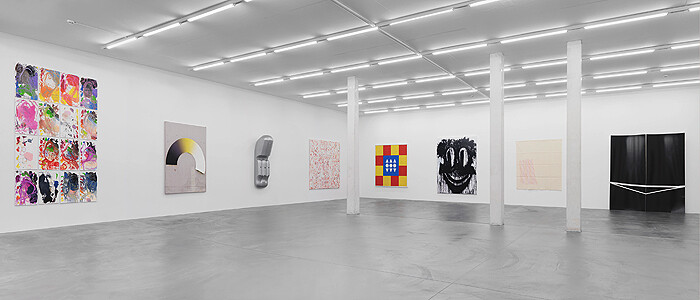Everything you see here has lived out a solitary life of its own in a shop window on a quiet street in the East Village. One by one, sixteen works by Martin Boyce, John Giorno, Wesley Martin Berg, Matteo Callegari, Wyatt Kahn, Alan Shields, Bruno Gironcoli, Ann Craven, Joyce Pensato, Josh Smith, Andrew Brischler, Giorgio Griffa, Tamuna Sirbiladze, Davis Rhodes, Ron Gorchov, Anne Chu, George Ortman, and Kes Zapkus were exhibited solo, between October 2010 and the present (with two more installations lined up). Curator, artist, and publisher Phong Bui, who has written the gallery text, compares that shop window on Great Jones Street to a device linking disparate elements, a “magic object” à la jewelled ring via Italo Calvino’s parsing of the story of Emperor Charlemagne who fell for whoever possessed the ring: “Around the magic object there forms a kind of force field that is in fact the territory of the story itself. We might say that the magic object is an outward and visible sign that reveals the connection between people or between events.” (from Italo Calvino’s collection of lectures, Six Memos for the Next Millennium, 1985–1986)
Bui’s text also includes his poem “Life is a Killer,” a flȃneur’s account of walking in the city, in which one finds direct references to the works in the show: the “man, wearing an unusual hat, smoking a cigarette on the sidewalk” steps out of Berg’s black-on-black painting Black Sun (2012); one of the “amorini, putti, grounded in flight” threatens to crush the bronze horse on which it is mounted in Chu’s Putto on horse (2012), the only free-standing sculpture in a show mostly populated by works on canvas two or three meters tall. And the title of the poem is lifted from Giorno’s 2012 canvas of the same name, a title he has already employed several times over.
What’s a tad strange about all this is that the premise of the show is fictional—these works were not shown in that modest shop window at all: lesson learned, don’t believe everything that a press text implies. These are different works by the same artists. The text is also oddly coy about the glue to that connection once removed—that “39greatjones” is an art project from Swiss artist Ugo Rondinone, who has been at the core of Eva Presenhuber’s program for some decades, through several iterations of her gallery. He shows works by fellow artists, friends he admires, in the window. He also includes works by the man he has lived with for more than a decade: legendary poet and artist Giorno, who also performed on opening night, stretching vowels to their limits in several of his own poems and bringing the neuroses beloved of New York to Protestant Zurich. Giorno told us of “the golden age of promiscuity” and Andy Warhol laughing last—local reformer Zwingli might have been turning in his grave, had his ashes not been scattered in the wind back in the sixteenth century.
Since 1998, Rondinone has been living in New York, and the force field that binds all the works in this show is his network. While by no means a revelation, this is in and of itself interesting, and says much about the way the art world works today. How many juries and curators are guided, if not led, by the networked-ness of artists? If an artist does not have recognizable names or landmarks on their CV, or if their work is not already familiar, what chance do they have of success? The reality is bleak, and the consequences of the phenomenon worth considering. But relying on a network has positive aspects as well—when you can’t see the wood for the trees, who better to rely on for recommendations or critique than your trusted friends and colleagues? And how a curator’s network functions is not the same as how contacts influence an artist’s operations, nor a dealer’s deals.
So the main problem with this exhibition is that it is an opportunity squandered. Here are the people that surround Rondinone in a vibrant urban context, a catholic collection of young and old, famous and undervalued, and each of them occupied the white-panelled space of the Great Jones Street window of late. How did it grab the attention of passersby? While Shields’s large canvas Single Swing Encounter (1980/1981) makes a striking first impression pinned to the wall in the Zurich exhibition, his modest work tap shoe count (1983), blurrily visible if you plug in the address on Google Street View, is the work I’d really like to see. Gironcoli’s polyester sculptural piece Objekt (1965) apes functionalism with faux screw holes and the smooth, simple form of something mass produced, but seeing a similar work in a shop window would add frisson. Here in Zurich the pedestrian gallery hang weighs down upon the works, and great energy is required to escape it. Rhodes’s Untitled (2007), two tall black panels of latex on foam board propped against the wall, is the exception in the show: it’s amazing how just a few white lines can achieve the momentary illusion of shielding the entrance to a space beyond.
Alternatively, at a time when schools or movements are largely démodé, and collective labels are applied caustically, how do artists interact? With the winds that blow from the North American art world dominated by the likes of Larry Gagosian and Steve Cohen, this show could have been an inspiring breath of fresh air. Of course, Eva Presenhuber operates a commercial gallery too, and no minor one at that, but a bit more effort in the installation and a clearer assertion of the exhibition’s premise could have resulted in a much more exciting show. Business as usual, anyone?






